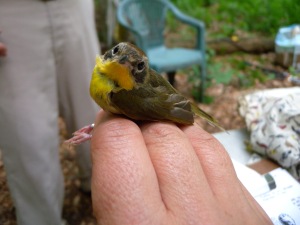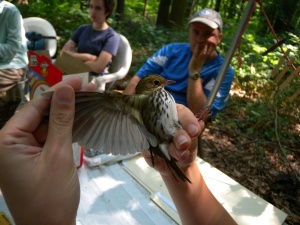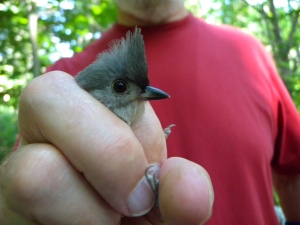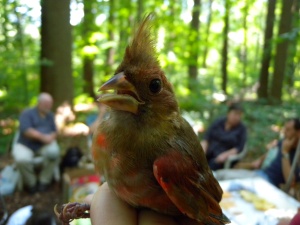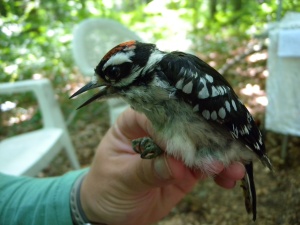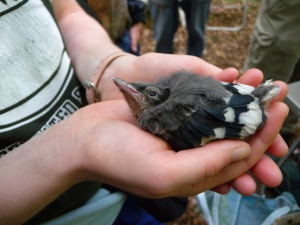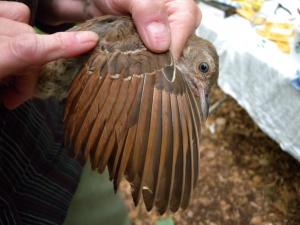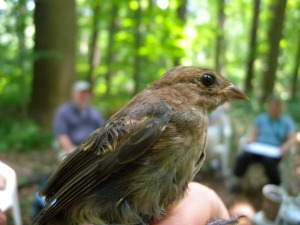…. “Those little nimble musicians of the air, that warble forth their curious ditties, with which nature hath furnished them to the shame of art.”
~Izaak Walton

The little colorful warblers have indeed begun streaming down from the North to grace us with their fleeting presence this autumn. I think the hurricane may even have helped to stir them up a little. On the day of Irene’s visit, before it got really nasty, I spotted a visiting Black-and-white Warbler and a lovely pair of American Redstarts hunting insects in my yard, and Doris (our Master Bander) had a Canada Warbler in hers. Unfortunately, we won’t hear the warblers’ “curious ditties” much, if at all, because they are more cryptic during fall migration in both voice and plumage. This is why you hear the term “confusing fall warblers”; identification is extra challenging because they are not in their bright breeding plumage, differences between species are more subtle, young males born this year look an awful lot like adult females, and song is no longer a dead giveaway! But if you want to start studying your bird songs in preparation for next spring, here is a great resource: Nature Instruct.org.

And of course, you are invited to drop by our banding station (no sign-up required) this fall to see, touch, and learn more about these beautiful migrants that visit Rushton Woods Preserve. We are in the process of clearing vegetation from the net lanes and finishing data entry from summer MAPS banding. We are eager to start the passerine banding season next week on Tuesday September 6 and will band every Tuesday and Thursday from sunrise to 11am (when it’s not raining) through Nov 1st. Public Northern Saw-whet Owl banding (by reservation only) will begin the week of October, probably Friday October 7th. More on that to come…
Check out these unbelievable pictures of an incredible early morning fallout of migrants, mostly warblers, this past spring on Machias Seal Island, Canada. Be sure to scroll through all 12 pictures! Those poor birds are so exhausted they are letting the photographer pick them up in his hand. We forget how amazing a feat these migrations are for such small creatures… It literally almost kills them. I wonder what these birds are saying to each other…Anyway, this is the type of fallout we are hoping for at Rushton this fall! Miracles happen, right?
Speaking of fallouts, did you hear about the exotic seabirds that Hurricane Irene blew in last week? Birders were going crazy along the Delaware River and Cape May checking off life birds they would normally have only been able to see by taking a trip out to the sea or the islands. These seabirds travel effortlessly in the relatively calm eye of the storm and then drop out into ‘new worlds’ when the storm begins to weaken. Sightings included 10 species of terns including a Bridled Tern and a Sandwich Tern (Who thinks of these names?), a Jaeger, and even a Whitetailed Tropic Bird, normally seen in Bermuda and the Caribbean. Very exciting.

Although some birds can travel unscathed through the eye of a hurricane, I’m sure Irene forced the burgeoning Monarch butterfly migration to a screeching halt! All the rain in general last month seems to have slowed the butterflies down; we didn’t find many Monarchs or other butterflies during last week’s PA Young Birder meeting, “Monarch Madness.” We did find and observe one tiny Monarch larvae, one Spicebush swallowtail adult, and some praying mantises! The children had fun bug hunting and learning all about Monarch life cycles and migration while wearing their “thinking antennae!” Please read more about this community event and see the great pictures by photographer Amanda Mahnke in The Malvern Patch!

This month’s PA Young Birder meeting will take place at Rushton Woods Preserve on Saturday September 24, 9-11 AM. The little birders will discover the fabulous fall migrants as they join us for songbird banding. They’ll see that around this time of year, Rushton becomes a hoppin’ Bed and Breakfast Inn for a multitude of different bird species, many of which we don’t see during any other time of the year. Each Jr. Birder will also get to spend a life changing personal moment with some of these special avian visitors before they continue on their way south for migration vacation! Interested Jr. Birders should RSVP to Lisa Kiziuk (lkr@wctrust.org).
Side note: Don’t forget to contact me (bhg@wctrust.org) if you are interested in volunteering to monitor our milkweed patch at Rushton for monarch larvae or to tag migrant adult monarchs this month. The data from these citizen science projects is crucial to Monarch butterfly conservation.

There is yet another interesting migration event that I should let you in on…. Nighthawks. Most active during dawn and dusk, they say these strange birds are the missing evolutionary link between diurnal birds and owls. They sort of look like owls with their cryptic coloration, they fly like bats skillfully catching mosquitoes out of the air, and they have the word ‘hawk” in their name. So what is it? It is actually a member of the Nightjar family and related to the Whipoorwill. Right now, these strange little birds are migrating by the hundreds to South America, and you can view this fascinating phenomenon at the Haverford College Observatory from 6-8pm any evening from now until September 11. Observers saw 648 migrating nighthawks last night! Better than a fireworks show! Read more in the BCDC blog
Unfortunately, migration may be the only time most people see nighthawks in this area. Although their “peent” call used to be a familiar sound in cities and towns, they are now thought to be declining through most of their range as a result of changes in roofing. They prefer to nest on old fashioned, flat peastone gravel roofs and hunt for insects attracted to city lights. Project Nighthawk is an Audubon initiative encouraging people to create gravel nest patches on their roofs. This is a project we hope to become involved with in the near future as well! Go to the Project Nighthawk website for more info.
And last but not least, while we are sort of on the topic of hawks…here are two remarkable videos about hawks that are worth watching:
“Parahawking” over the skies in Nepal (watch in HD)
Goshawk in slo-mo (only works in full-screen mode)
Oh and don’t forget to plan a visit to Hawk Mountain this Fall! No Goshawks so far, but they’ve had 700 raptor migrants of 14 species in addition to many species of warblers. Click here to see the count. And since we like Monarchs too, I’ll tell you that their Monarch Celebration day is September 17th.
Have fun, and I hope to see you at the Rushton banding station soon!
~Blake







